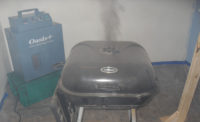Study: Production of Hydroxyl Radicals Breaks Down Air Pollutants

Residents in some areas of the developing world are currently coping with dangerous levels of air pollution. Recent research, co-led by the U.S. Department of Energy's (DOE) Argonne National Laboratory, is leading to a new understanding of a key chemical able to break down some major air pollutants.
Argonne's Stephen Klippenstein and his collaborators at the University of Pennsylvania examined the Criegee intermediate, a carbonyl oxide that consists of molecules able to break down sulfur dioxide and nitrogen dioxide. Scientists believe these molecules contribute to health issues.
"Astonishingly close agreement of our theoretical work and experimental data is providing important insights into the dynamics of chemical reactions," said Klippenstein.
According to Klippenstein, this research improves models for atmospheric chemistry. The team's work also further validates a major theory for predicting chemical reactivity.
The work allows researchers to understand the dissociation—or the separation of a molecule into atoms—of a prototypical Criegee intermediate in a new way. "This research demonstrates our grasp of tunneling on a molecular system that is of vital importance to the understanding of atmospheric chemistry," said Klippenstein, a distinguished fellow in Argonne's Chemical Sciences and Engineering Division who performed the theoretical calculations.
The researchers showed that quantum mechanical tunneling greatly enhances the production rate of hydroxyl radicals in alkene ozonolysis reactions, which sever multiple bonds under atmospheric conditions.
Hydroxyl radicals are important because of their role in breaking down many pollutants ...
Read the full article: https://phys.org/news/2017-12-production-hydroxyl-radicals-air-pollutants.html#jCp
Looking for a reprint of this article?
From high-res PDFs to custom plaques, order your copy today!







